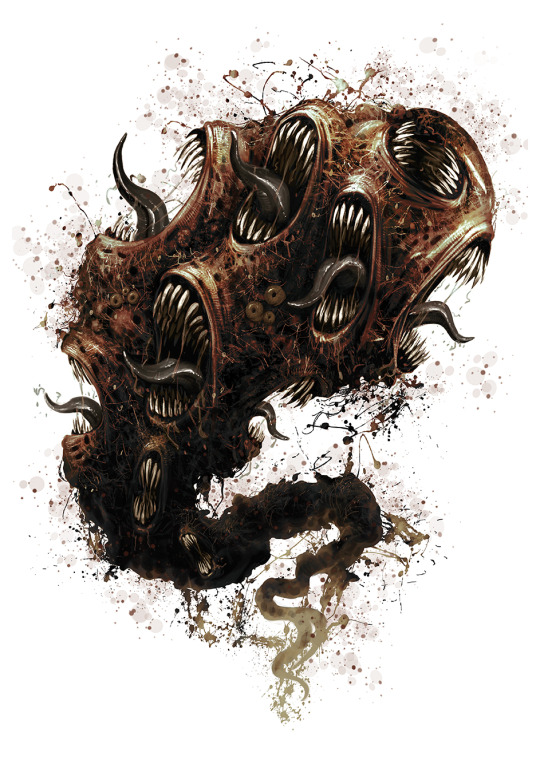#Flying polyp
Photo
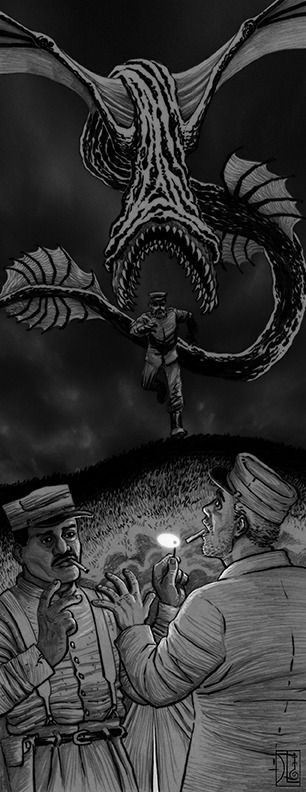

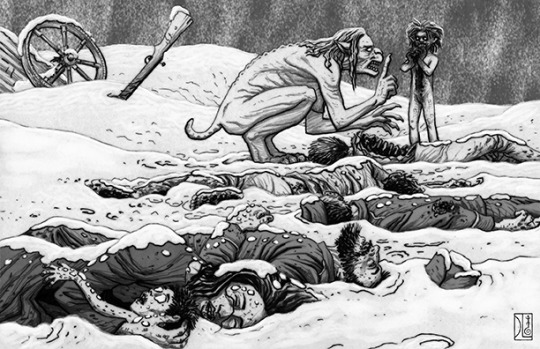

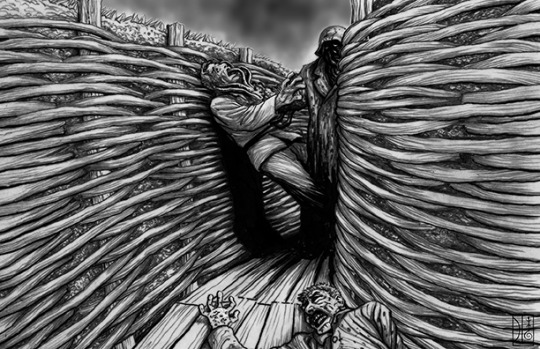
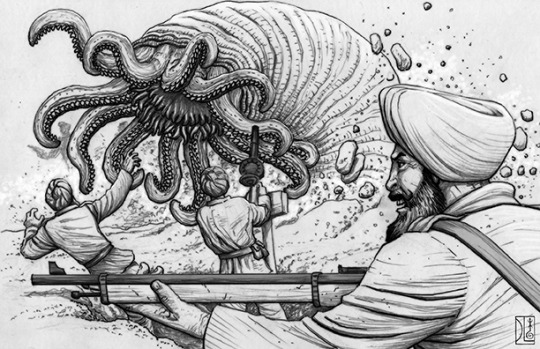
Illustrations from the WW1 Call of Cthulhu RPG. These weren’t for any specific scenario, just various encounters between hapless humans and eldritch horrors in some of the different theatres of the Great War.
33 notes
·
View notes
Text
Starfinder - Flying Polyps

This week we finish out the ancient Lovecraftian alien empires with the Flying Polyps, truly a horror from beyond space.
3 notes
·
View notes
Text
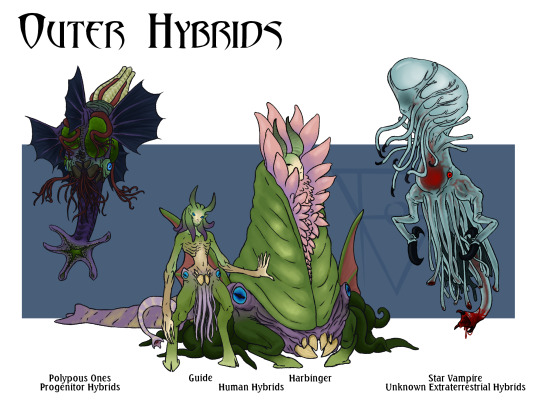
Them from Outside want in. Inside our universe of light and matter, so different from the formless chaos that roils around the universal font of Azathoth. Out there, they’re little more than plankton. Mere mouthfuls for larval Outer Gods.
But inside our universe, amongst the pitiful things that populate it, they’re the gods.
Their primary means of coming in is in the creation of the Outer Hybrids. They send whispers and instructions along the paths that they cannot tread alone, offering knowledge and power in exchange for aid. Success is rare but for those who exist outside of time, patience is supreme.
To make the biological connection, the Outer Ones instruct their conspirators in corrupted rituals of “connection” with Yog-Sothoth and inject their seeds when they are performed. Yog-Sothoth is the perfect interface between alien genetics, with its biological fusion of all multiversal life it can serve as the glue between even the most disconnected of species.
While its genes do end up as a part of the Hybrids, Yog Sothoth can only be said to be their father in the most technical sense. It does not have any agency in the process and doesn’t care for its misbegotten children. Indeed, Outer Hybrids that attempt to bring themselves to its attention are struck down without remorse.
When they succeed, the Hybrids will often be driven to open a true path into the universe for their forebears, now able to coordinate attempts from both sides of the divide. As the Hybrids work on the path they’ll scour worlds, blood and biomatter fuel for them to split and fissure and spawn. They’ll bloom in an orgy of self-devision until nothing else is left.
It is believed that this is what happened to the first biospheres of Venus and Mars and allowed the “Old Ones” to walk on Earth in the early days, as the Progenitors first colonised the system.
Common traits
Undimensioned and unseen. The Hybrids are generally invisible to common eyesight as they exist slightly out of phase with visible light. They can be seen by those who can look Beyond, or can make the Voorish Sign. Spreading the dust of Ibn Ghazi in the area where their presence is suspected can force them back into phase and thus fully visible.
Winds of magic. The presence of Hybrids is accompanied by cold winds and strange weather. While they seem to simply generate air currents, it actually comes from their influence on the psychokinetic energy field through their connection to Yog-Sothoth. In addition to the telekinetic currents, they can strike with subspatial lightning.
Vampirism. While they’re perfectly capable of consuming ordinary food, Outer Hybrids are also able to suck blood through their trunk-like tentacles. In many cases this is a catalyst for reproduction, triggering their growth to enormous size before splitting into numerous offspring.
Of two minds. We once thought some dinosaurs had two brains. In the Outer Hybrids, this is usually true. The brain in the usual place maintains the capabilities of the source species, preventing the Hybrid from being lost in rational space-time. The Outer mind manifests somewhere in the lower body of the Hybrid and leads its decision making when it comes to magic, reproduction and calling the Outer Ones. While both minds are aware and in constant communication, one tends to exist in a dream-like state while the other leads.
Known Hybrids
The Progenitors chose to make a Hybrid as an experiment after being swayed by promises of supreme biological power, the goal of all the earthly colonist’s scientific development. It resulted in a single larvae that grew to titanic size before bursting into hundreds of predatory flying polyps in seeming parody of the spore-based reproduction of the Progenitors. The conflicts between the Polyps and the Progenitors lasted millenia until the Yith chose Polyp territory to found the Library of Pnakotus. The Yith locked them away and squated above their prisons to dissuade the Progenitors from mounting all out attacks against the cities of the Yith. Now with the Yith gone the Polypous Ones are technically free but those that remain beneath the sands of Australia are old, long past their reproductive age and content to stay hidden and unbothered.
Human Hybrids have sprung up several times. Old Wizard Whateley forced his daughter Lavinia to carry them and led to the legend of the Dunwich Horror. In the distant future the Deathless Sorcerers will breed hundreds in hopes of powerful guardians and unwittingly create their future Empress. Al-Hazred himself was devoured by one in the marketplace of Damascus. One interesting thing about Human Hybrids is the frequency they are born in pairs, a firstborn Guide and a mighty Harbinger. The Guide tends towards the human, less developed biologically and sothically but much more in tune with human things. The Harbinger, on the other hand, inherits much more from its alien parents and is nearly incapable of surviving on its own in the alien environment of Earth. The division is not absolute, however. An aged Guide will become much like its brother over time; the Harbinger simply has a head start.
Star Vampires have been in the Sol system for as long as the Yith can perceive. What species spawned them is unknown. The Star Vampires maintain a single colony, hidden on a parallel Mars known as Rhylkos. They’re eusocial, with a spawning queen known to occultists as Uvhash, the Blood-Mad God of the Void. They sometimes come to Earth to take blood back to their queen. Their presence is always announced by an unnerving hyena-like cackle. Although it brings to mind malevolent laughter, the sound is an alien form of echolocation, pinging across the subspace veil in search of astral cords.
#cthulhu mythos#lovecraftian#eldritch#strange aeons#monsters#creature design#dunwich horror#wilbur whateley#horror#my art#star vampire#flying polyps
91 notes
·
View notes
Photo

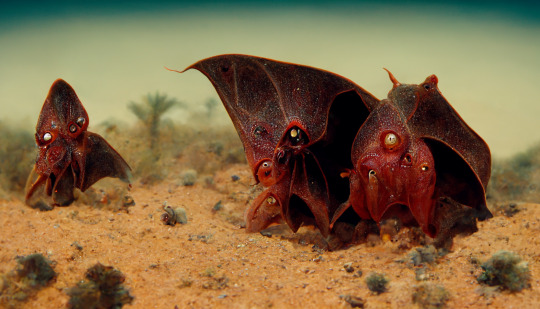

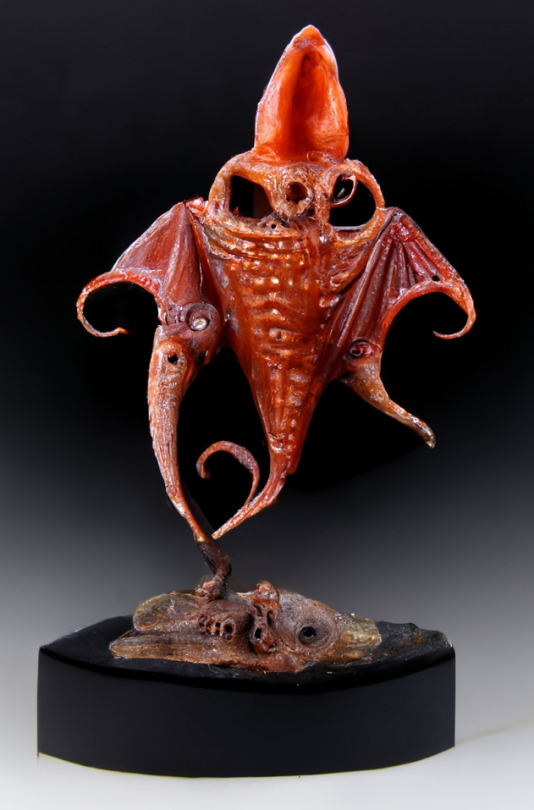
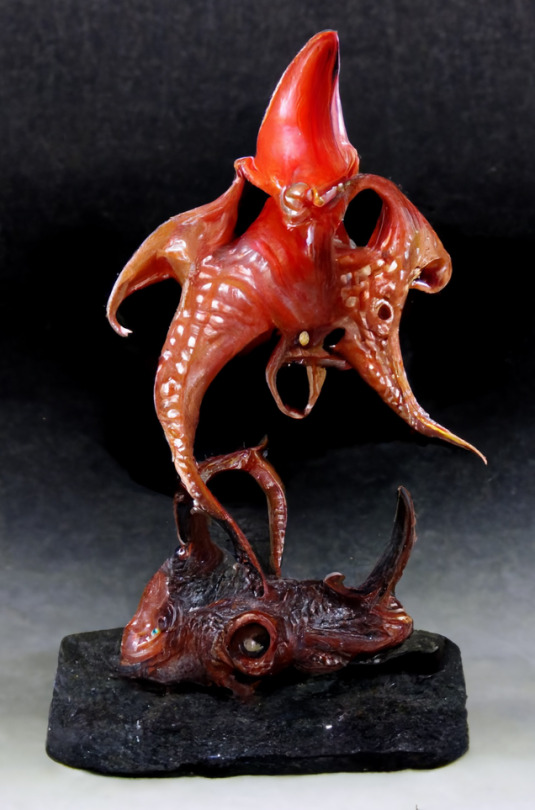

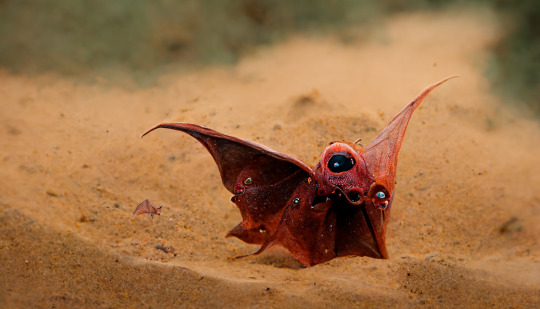
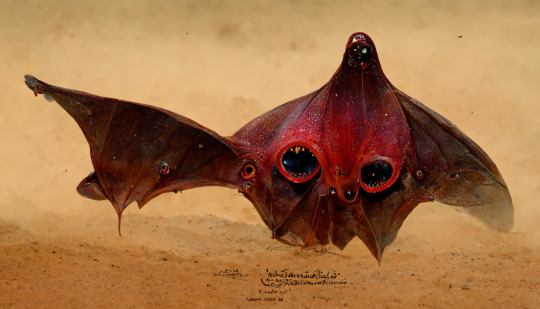
Diverse Vampyroteuthis-derived Lovecraftian monstrosities.
ROW 1: Haunter of the Dark (seen with night vision, apparently, because, you know, daylight)
ROW 2: Flying Polyps back in Teh Day
ROW 3: Stylized depiction of a Star Vampire from the Middle Ages, plus
ROW 4: contemporary figurines of same. I figured since the creatures are only visible when they've recently fed, a Star Vampire would be a good candidate for the unseen monstrosity that ripped Alhazred to pieces in broad daylight.
ROW 5: Ghuls, djinn of the desert wastes
#ai art#midjourney#vampire squid#lovecraft#cthulhu mythos#nyarlathotep#flying polyps#star vampires#ghouls#djinn
48 notes
·
View notes
Text
The Sea Creature of the Day is the Cosmic Jellyfish!!

it's been a bit since ive done a jellyfish and i saw a picture of these guys and just,,, 🥰🥰🥰🥰 flying saucer jellies!
i unfortunately don't know too much about them when it comes down to it :( i know that unlike a lot of jellies they don't have a polyp stage which is really unique and cool :3 i just think they're really neat looking
#marine biology#deep sea#sea creatures#aquatic life#sea creature of the day#ocean#ocean life#jellyfish#cosmic jelly
116 notes
·
View notes
Text
𝐎𝐧 𝐭𝐡𝐞 𝐬𝐮𝐛𝐣𝐞𝐜𝐭 𝐨𝐟 𝐉𝐞𝐚𝐧 𝐉𝐚𝐜𝐤𝐞𝐭
I’m kinda surprised that nobody so far has made the comparison between the alien Jean Jacket from Jordan Peele’s Nope, and the flying polyps from H.P. Lovecraft’s horror story the Shadow Out of Time. They’re both creatures from outer space, described as aggressive and predatory, they can both camouflage themselves at will to avoid detection, they can manipulate wind and weather, are often noticed by the whistling and screaming noises they make as they pass by, they can both distort their bodies to change their shape and size, and they both attack their prey by sucking them up into a vortex though the sky. But here’s the REAL kicker. They especially hate to be noticed by people, and will attack anyone that directly looks at them. That being said however, I’m not entirely convinced that Jean Jacket is supposed to be a flying polyp, despite the similarities. It’s my own personal theory that Jean Jacket’s species (Occulonimbus Edoequus) originated from a gas-giant planet, or more accurately, 𝐉𝐮𝐩𝐢𝐭𝐞𝐫. Because think about it, if I were a massive ambush predator that could camouflage specifically into a cloud, where would I prefer to live? Somewhere that’s constantly surrounded by swirling clouds seems like the perfect habitat for our favorite vore-roomba’s species to live. And it also kinda makes what happened to Jupe, Mary Jo Elliott, Jupe’s family and the other 40 people at the Star Lasso experience that much more horrific in hindsight.
𝐈𝐧 𝐭𝐡𝐞 𝐞𝐧𝐝, 𝐭𝐡𝐞𝐲 𝐰𝐞𝐫𝐞 𝐚𝐥𝐥 𝐉𝐮𝐩𝐢𝐭𝐞𝐫'𝐬 𝐂𝐥𝐚𝐢𝐦.
724 notes
·
View notes
Text
🌊Latin name: Glaucus atlanticus
🌊Common name: Blue sea dragon, Sea swallow, Blue angel, Dragon slug
🌊Family: Glaucidae

Probably the most well known sea slug on the internet, famous for its interesting appearance and many videos of people handling it.

🌐Found throughout the Atlantic, Pacific, and Indian Oceans in tropical and subtropical waters. They appear mostly on the surface, floating on its back - an air bubble in its stomach helping it maintain buoyancy. That does mean they can accidentaly wash up on beaches, hence many videos of people handling it.

💫 Fun fact: A group of blue glaucuses floating together is called a “blue fleet.”
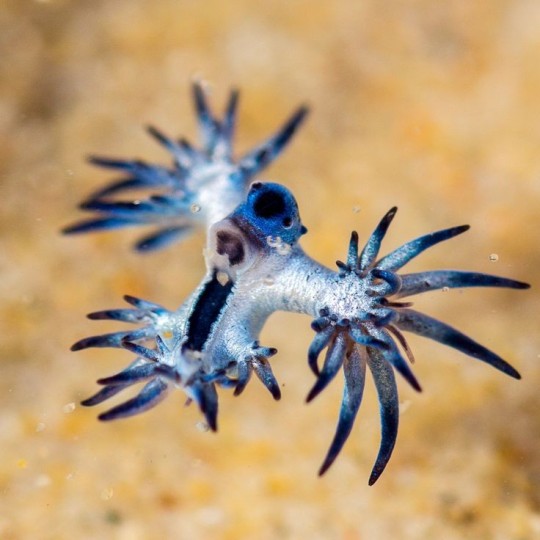
🖍Their coloration is an example of countershading - its bright blue underside helps the blue glaucus blend into the water’s surface while its grayish backside helps it blend into the ocean when spotted from below, camouflaging it from both flying and swimming predators while floating in open water.
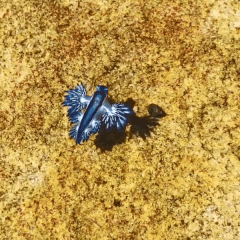
🍽 This silly guy is a predator. It hunts larger marine organisms, e.g. plant Physalia physalis, the polyp Porpita porpita or the snail Janthina janthina. Occasionally, some individuals may resort to c-nnib-lism.



⚠️As mentioned before, these nudibranches feed on what is called Portuguese Man-O’-war (Physalia physalis) - venomous prey - which also makes them venomous. This venom is stored in the ceratas (refer to picture above; dark blue finger like ceratas), the more Physalia it eats -> the more concentrated the venom will be.

And for those interested in more of this silly slug:
Video of a dancing Glaucus atlanticus
Video of a Glaucus atlanticus being properly handled
Video of the silly chilling
#ocean#nature#deep sea#nudibranch#marine animals#marine life#marine biology#seaslug#sea slug#seaslug haven#glaucidae#glaucus atlanticus#blue sea dragon#sea swallow#blue angel#dragon slug#19.11.2023
32 notes
·
View notes
Text
Funny faces
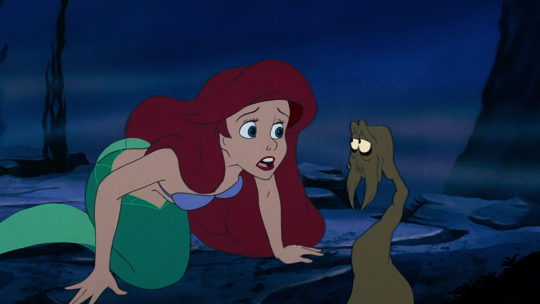
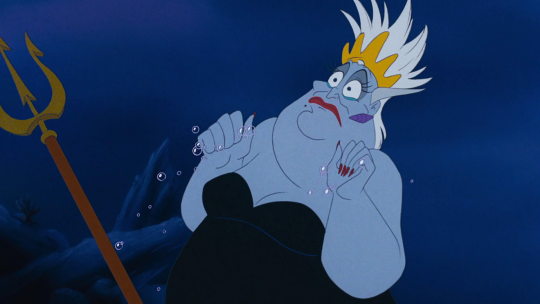



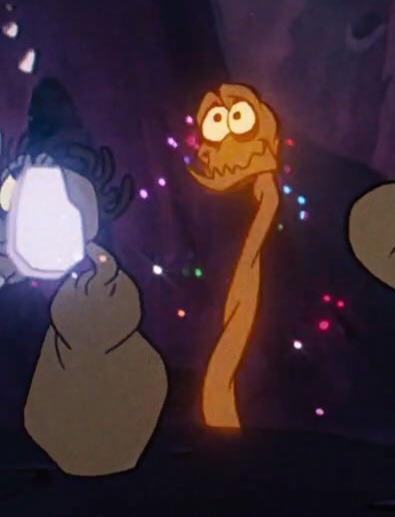
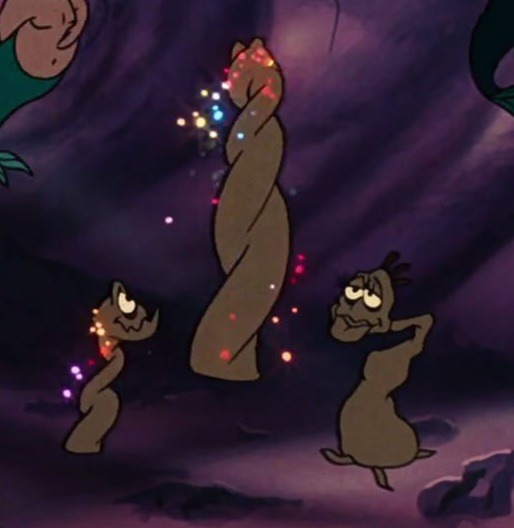
That Jamaican polyp owed Ursula money for...sea-weed. (Ducks flying tomatoes.)
#the little mermaid#the little mermaid 1989#disney screencaps#screencap#polyps#Ursula's garden#ariel#ursula#kimg triton#jamaican#transformation#pollyps
25 notes
·
View notes
Text

There are just some species out there that seem to have been put on this planet for the main reason of making it more wondrous. Like they are the extra touches from a painter to really make the scene bloom and come to life. Obviously, yes, they actually do play a role in the ecosystem and food web, but I am talking more on whimsy here! Creatures and plants that you just look at and feel like you are witnessing a piece of living art. When you see great flocks of colorful birds take to the skies, or rivers packed with migrating fish as they leap and dance! I can certainly look at all these things and explain their purpose and what they are actually doing, but it does always force me to take a second and really drink in the sight. It always makes me happy when I experience things like this, because some days I feel like I have seen it all, or that I have grown numb to the wonders of nature. When I witness such incredible things, I am reminded that there is still so much to see. And perhaps I am not immune to the beauty and charm, no matter how many times I feel it. In fact, I think I grow more and more susceptible to it, as I always find new ways to fall in love with nature. This entry is on one of those species that really gave me one of those moments. When I stepped into the bustling streets of a local festival, enjoying all the lights, decorations and excited people. Seeing the parades and costumes go by, and then looking up from it all to see several Nectengshe floating through the sky, the stars of this wondrous festival. I would say words can't explain it, but I feel that I could given enough time and ink! What I should say is Eucella won't let me use the incredible amount of words I would need to explain it, so we will just say it was a breathtaking sight. I will always hold this species in a special place in my heart, from that first sight and the extraordinary festivities I got to partake in!
The Nectengshe are often jokingly referred to as "tourist dragons" by the locals, but not meaning that this species is not from around here. What they mean is that outsiders and visitors who aren't familiar with this species will show up, look to the sky and scream "LOOK! DRAGONS!" or "BY THE GODS! DRAGONS!," to which all the locals laugh. Indeed, they find it funny because the Nectengshe are not dragons, not in the slightest. They aren't reptiles, in fact they don't even have bones! They are actually a colonial organism, similar to the Ikuchi, that grows and sticks together to create a serpentine shape. The whole "creature" is just a massive collection of specialized, sacs, tendrils and polyps that work together to act as a single being. By producing a special gas in combination to their incredibly light weight, they can easily float through the air, building and releasing this gas to let them rise and fall as needed. Though this brings to mind the idea of flight, they don't actually do any real flying or soaring. Rather, they prefer to let the wind take them, only using minor movements of their own to keep them upright and in one piece. When you see them live and in the wild, they make you think more of a decoration than a creature, like someone's puppet blew away and is now hanging above your head forever. I will admit, the dangling tentacles do bring to mind streamers, and that many decorations during the festival looked almost exactly like this species.
For what they do, the answer is: not much. They just float through the air and live as long as fate lets them. For food, they use their tangling tentacles to pick up small bits from the air, like pollen, spores, tiny aerial creatures and such. They are adhesive and also have painful stingers for larger prey that gets tangled up. They sometimes eat the clumsy birds and bats that run into them, never picky as long as it doesn't break free from their grip. When a tendril has a hold of a good chunk of food, it retracts upward into the colony body and deposits it. The food will be digested and distributed, while the limb drops back down for more. It gets all it needs from the air around, be it prey or water. Their very slow and carefree looking lifestyle means they don't need a whole lot to get by, so a few days of slim pickings is no big deal for them. Also, the stinging tendrils they have help protect them from aerial predators, that is if something actually decides to attack them. As you can see, the Nectengshe bears a very strong resemblance to the dragons that can be found in this part of the world. Obviously, very few things really tangle with such powerful beasts, and it seems these colonies are trying to get in on that intimidation. Often a single glimpse of a dragon soaring through the sky is enough to make most creatures turn and run, so if the Nectengshe looks enough like it, many predators won't stick around for closer inspection. It is a pretty good trick, and one that has some unforeseen benefits!
Since this species doesn't actually do a whole lot, just float and eat whatever runs into them, it makes sense that people that live around them don't mind them. The worst a Nectengshe can do is accidentally get blown onto their roofs or get tangled in some flags. If one dies and drops upon their heads, it is a problem, but more so for clean up and whatever stings you may get. However, it isn't that people don't pay attention to them, as folks actually do love this species a whole lot! It should be obvious with the festival I was at, which was celebrating the annual bloom of Nectengshe, when this species is most prevalent in their skies! The species is looked upon fondly, as others find them quite beautiful and serene to watch! The other thing to point out is that in this part of the world, most folk actually like and even revere dragons! They see them more as symbols of wisdom, strength and ascension rather than as giant destructive monsters. Yes, they do have their fair share of dragons that do cause death and damage, but it doesn't seem to dampen their overall views. And since the Nectengshe bear a resemblance to these beloved serpents, the species gets to enjoy some of that appreciation too! Like I said, a pretty neat trick! Just float around and do nothing, and still have crowds of adoring fans! Kind of makes me envious some days!
Chlora Myron
Dryad Natural Historian
--------------------------------------
"Nectengshe"
So continues the endless journey of posting Not Dragons during Dragon Month. I swear I make real ones! I do! They are just....well.....uh.....hmmmm...
34 notes
·
View notes
Text
Jean Jacket is a Flying Polyp change my mind

9 notes
·
View notes
Text

the dragon
I'm coming up with this on the fly just for you! @esraeh
I'm thinking he's a watery boi! This one lives in the ocean, but there are subspecies that live in other bodies of water!
His colors are probably blue and aqua because.. i like those colors :3c And his horns are actually a type of staghorn coral! Young dragons are encouraged to seek out polyps of coral to attach to themselves, and it becomes a symbiotic relationship--the dragon gains ornamental beauty which will help in impressing a mate later in life (if they take care of their coral colony), and the coral is strengthened by the dragon's magic to withstand the currents caused by its movements, as well as more access to food as the dragon moves around. The selected coral can be of any type--some might even choose non-coral ornaments such as barnacles or anemones.
Prey is realistically anything they can catch or fit in their mouths, but they prefer larger fish or even cetaceans depending on the dragon's size. Anything that comes to try and damage its coral colony or other symbiotic organisms is fair game, including humans who may want the bragging rights of having a dragon's horn, although it's highly illegal and generally not worth the risk. Once the coral is broken off, it's disconnected from the dragon's magic and just becomes normal coral again, eventually bleaching and becoming brittle. Doesn't stop people from trying, though.
If a community discovers one of their own has attacked a dragon for their horns, they will often offer apology in the way of offerings of fresh fish, or redouble efforts to keep the waters clean to ensure the ecosystem is healthy for future generations of dragons.
One could say that the colony of creatures they carry symbiotically is their hoard! Most dragons will continue to accumulate more over their lifetime, the longest lived and most powerful eventually becoming massive slow-moving ecosystems. When a dragon eventually dies, all those magically-charged nutrients are put to good use, supercharging the colony's growth to form a sturdy foundation underneath itself so it can still stand once the soft body has degenerated. The dragon's body and what's left of its magics feed the local ecosystem for days, if not weeks, boosting the health of any animals who feed from it.
Their abilities include: water current manipulation, allowing them to move as quickly as they please despite any hydrodynamic drag their accumulated colonies might normally incur; in the same vein, they can control water in a way to always hold it against their body, useful for rare times when they might emerge from the water, to keep their colonies alive while they move around on land; they can fly but typically reserve the usage of that movement for underwater travel, unless leaving their home body of water due to unlivable conditions. Water purification: ability to use their magics to change the chemical composition of water, which helps them keep their ecosystem healthy, and also helps their human neighbors.
As humans depend heavily on water, it's no surprise that dragons and humans might come into contact with each other. But most communities quickly form a protective bond with their local dragon, understanding that a healthy ecosystem = a healthy dragon, and a healthy dragon = a robust, healthy ecosystem. A dragon's presence means that food is abundant and healthy, as well as protected for decades or centuries to come. Humans help keep the beaches and shorelines clean, taking what they need for food without overfishing, and in return dragons help keep human communities safe from waterfront storms, and purify water for them to drink.
8 notes
·
View notes
Text
tw: menstruation (Probably more detail than you want to know)
Growing list of reasons to yeet my ute: have now experienced a decidual cast twice in a row, and oh my fucking god ow??? I'm no stranger to menstrual cramps, but damn! The cramps leading up are bad enough, but that final set of cramps had me flying out of bed going "what the FUCK is happening down there?!?!" And then. You feel it. you fucking feel it exit *shudder*
Why do I still have this thing? I have to schedule another ultrasound, but this time they're squirting water into my uterus. Not looking forward to that - doc gave me valium to keep me calm during the proceedure, and I'm gonna be a bad egg and take a ton of ibuprofen and tylenol. Then we'll know what's going on with this possible polyp, and hopefully start the process of ripping the whole system out. So fucking tired of it.
9 notes
·
View notes
Text
In celebration of "giant snake" / "creature of eyes teeth and horror" being mentioned in the latest chapter of TCOTI:
There was a reference sheet one and only Lorel drew and posted somewhere on Tumblr that I cannot find anymore where is it I swear I was looking at it while I drew this
But here's what I imagined the mongrel to look like, based on the reference sheet and descriptions from the novel:
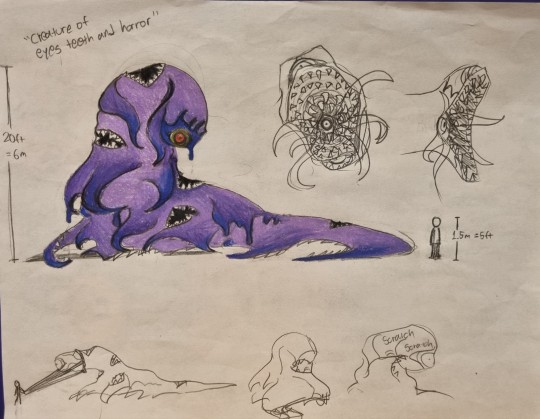
Basically, a flying polyp and a sea lamprey and goopy tentacles, all in one.
Oh and that thing shrinks down to like 6 inches too
By far Fresh is ranked 2nd on Characters that Made me Scream. I seriously love how he's portrayed.
In fact I want to write an essay on how much I love his characterization but then I'm afraid half of my interpertations on his character are going to be wrong i don't know i might be overthinking but I love him I can't help it
Fresh belongs to loverofpiggies
TCOTI is made by @onlyplatonicirl
53 notes
·
View notes
Text

BEHOLDER POLYP
Beholder Polyps, also known as Harlequin Vaugr Lanterns or Flying Motley, are a specialized parasitic organism created by projecting concentrated Abyssal Aurae onto corporeal biomass. Such biomass is usually accumulated into a crude pile of mashed corpses by smaller Fae-rotten creatures, in service to an Archfae from beyond the material plane. The polyp, once created near a rift into the Abyss, searches out for for the smell of a Great Dragon. Wychunters theorize they do this with the help of a yet-undetermined organelle, honing in to the smell of a Great Dragon’s arcanorganic catalyst-organs which allow them to cast fantastical spells without the use of focii.
Beholder Polyps are not uniform in structure, but follow an basic body plan which includes a central trunk or mantle which hosts the majority of the brain & sensory organs, one or more large eyes, a pair or more buoyancy organs, and a suite of respiratory & digestive apparatuses. The primary respiratory system has an additional pathway connected to the digestive system. The parasite does need to feed semi-regularly until it reaches a suitable host using its various bioluminescent bands & lures to dazzle smaller animals such as bats, small reptiles, large insects and birds. Once stunned with pulsating bands of light, the Polyp will extrude its lung-beak from below the central trunk & burrow into the host’s lower spine first, consuming the spinal column before working its way to the brain for its fatty contents. Sated, the Polyp lifts into the air once again with an acrid jet of glittering air and it continues it’s hunt.
Upon reaching a suitable host, the Great Dragon in question will already have been dazed by isolation and madness in most cases. The Polyp enters the victim’s Lair & will send out powerful psionic and pheromonal pulses to make contact, zero in, and settle at the lower spine above the hind legs. With powerful numbing agents and the host’s mind fully enticed by Fae promises of power and strength, the Polyp engages its suite of digestive organs surrounding the lung-beak’s housing to dissolve away tough scales & tissue. The lung-beak extrudes one final time, gnawing away with insectile consistency until the wound is large enough to accept the digestive suite. The parasite then anchors itself and its brain & nervous system burrows deeper into the host, leaving its body to atrophy & wither eventually into a dangling skintag.
#d&d#horror#body horror#dark fantasy#horror fantasy#faeries#fae#fairies#feyfolk#abyss#art#mine#wyrmspire#concept art#d&d concept art#dungeons and dragons#dungeons and dragons concept art#fantasy concept art#fantasy art#fantasy illustration#speculative biology#speculative evolution#spec bio#spec evo#fantasy#monster manual#worldbuilding
56 notes
·
View notes
Text
youtube
Be Warned
Someone more merciful should have guarded us against this horror beyond life’s edges. Perhaps they thought they had. Perhaps in the mental strain from such a horrendous enormity too vast for any human mind to absorb and conceive they hoped they could balance their need to unburden their broken psyche and still protect the foolishly curious from fathomless chaos. I can only imagine them desperately breaking and frantically burying smaller and smaller portions before their knowledge of the grotesque maddening whole destroyed the very last squalid traces of their shattered humanity.
But can you truly dilute the most malignant poison or bury it deep enough in soil to prevent it from leaching out to corrupt all that it touches or worse seeping out into the groundwater to infect wide swaths of poor naif innocents. Our salted and sickened earth should have taught us to know better. These howling blasphemous potentialities will not lie dormant nor hidden in the far reaches of the internet. Vindictive squirming packets ceaselessly groping towards each other like sharp toothed eyeless bottom feeders tunneling hungry through distended elephantine carrion. It whispers out through the barren darkness to claw bloodily into our idiot eyes and bleed out one’s very essence as easily and readily as a long stabbing limbed spider drinks its fill of the twitching fly. Though how I envy that fly for his suffering will be final.
HEED THE WARNINGS WHICH I HAD NOT. Avert your eyes before it is too late for you as it has become for me. Oh foolishly the first glimpses proved so sweet and rapturous just as the Sirens’ songs must have been to many a sailor never returned from sea. The thrill of these forbidden and taboo sights drove me onward deeper and deeper into a spiraling depravity: a banned sub-reddit; the deleted vlog rants of mad FinTech Bro Alhaz Satosh; Elon’s Twitter. By the time I found myself reassembling, converting and merging RealVideo files hidden in directories behind fake Anglefire personal sites I knew myself too consumed by its obscene polypous perversion. I can no longer help nor abide what I have brought back forth into this world. I can only beg you to look away.
#a kind of madness i suppose#or some audio visual wallpaper#anyway did you know#the top Hor berlin vidoes have millions of views and the lowest are under 50#moving pictures
3 notes
·
View notes





